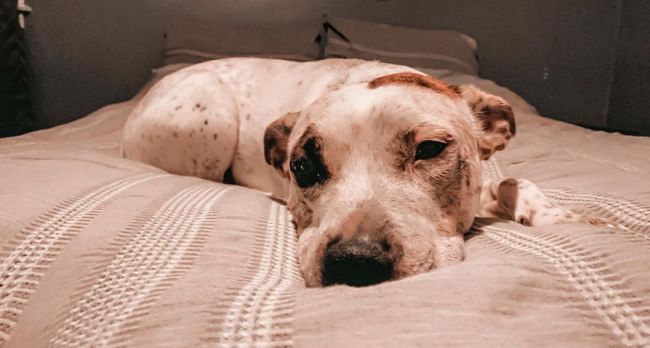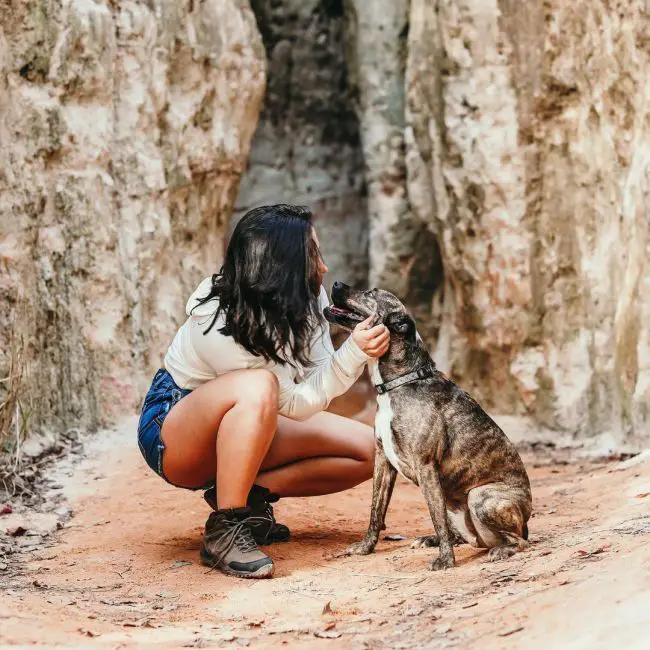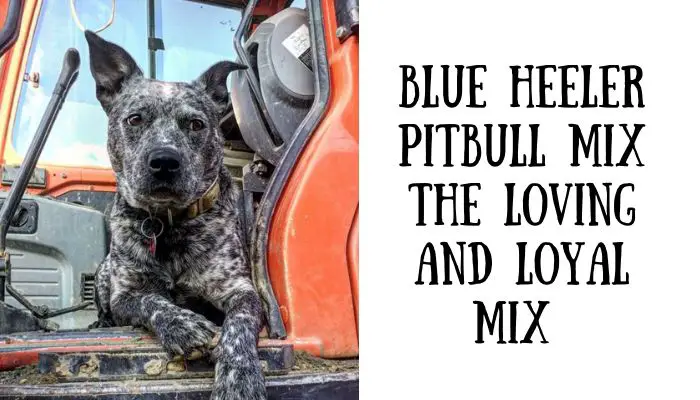Are you looking for a unique dog breed that is loving and loyal? You might want to consider the charming Heeler Pitbull mix. They are also known as Blue Heeler Pit, Queensland Pit, and Bull Heeler. It is a mix of the American Pitbull Terrier and the Australian Cattle Dog or the Blue Heeler. They are considered modern designer dogs, and there is still limited information about them.
Many owners describe these dogs as loving family pets with a strong herding and loyal personality inherited from their parents. These dogs are also muscular, athletic with powerful jaws and high energy levels. They would need daily exercise and stimulation from owners who can handle them. It requires minimal grooming, but they are well-suited for moderately cold climates because of their thick coat.
However, similar to other mixed breeds, it is hard to figure out the appearance and temperament of your Blue Heeler Pitbull mix. It can take most of its look for one of its parents or have the perfect blend. So, the best way for you to understand how to care for them is to consider the parent breeds’ good and bad qualities. You must understand their uniqueness so that you can prepare for proper care and attention.
Fortunately, we have found essential information that we can share with you about these Blue Heeler Pitbull mix dogs. If you are interested in taking one of these mixes home, read on to know more about their appearance, temperament, grooming, and training needs.
The Origin of the Blue Heeler Pitbull Mix

Designer dogs are gaining popularity in recent years. These dogs are now more common in households around the world. Because of their newness, there is still limited information about them – including their exact origin. To understand the Heeler Pitbull mix better, let’s take a look at its parent breeds – the American Pitbull Terrier and the Australian Cattle Dog.
The American Pitbull Terrier originated from breeding various terrier-type dogs such as the White English Terrier, Black and Tan Terrier, and Fox terrier with an English Bulldog. Pitbulls were trained to manage bulls for butchers and hold games such as wild boars. They were also engaged in bull-baiting and other blood sports. Fortunately, these sports were outlawed, and Pitbulls accompanied immigrants to the United States in the mid-1800s. They served as farm helpers and companions. Despite some lousy reputation due to their history as aggressive dogs, Pitbulls are considered loving, loyal, and protective family dogs.
Likewise, the Australian Cattle Dog or Blue Heeler are herding dogs bred in the Australian Outback in the 1800s. They were the result of crossing working dog breeds such as Black and Tan Kelpies, Dalmatians, and Blue Merle Collies with local wild Dingoes. Breeders aim to create a breed that can work in the rough and tumble weather and environmental conditions of the Outback.
Crossbreeding different dog breeds aims to produce hybrids with fewer health problems and positive traits from both parents. However, it is not always guaranteed. Some crossbreeds are still predisposed to the same health conditions as their parent breeds.
The Size and Weight of the Blue Heeler Pitbull Mix
Like a cross between two medium-sized breeds, the Blue Heeler Pit mix is also a medium-sized hybrid that stands from 17 to 21 inches tall. It weighs around 30 to 60 pounds. Males are slightly taller and heavier than females.
The Appearance of A Blue Heeler Pitbull Mix
Pit Heelers may take after the looks of its American Pit Bull Terrier or its Australian Cattle Dog parent. It may also have a perfect mix of these two. Often, they are slightly longer than they are tall. They have a muscular chest, a strong back, and broad hindquarters, which are the Blue Heeler characteristics.
However, some puppies may inherit the Pitbull’s shorter lions and the narrowing shape of the torso. Its head is often like the rounded skull of the Pitbull with ears that are high on the head and slightly pointed. These dogs have medium-sized expressive eyes that are likely to be brown.
A Pit Heeler mixes often have a short and thick coat with grey, brown, or white colors like the Pitbulls. It tends to be striped, blue mottled, or spotted like in the Australian Cattle dog if they have markings.
The Temperament of the Blue Heeler Pitbull Mix

Blue Heeler Pitbull mixed dogs make excellent family pets when trained and socialized correctly while they are young. Its Australian Cattle Dog parent is a great companion dog, and it has passed on the trait to this sweet and loving mix. They are obedient and easy to train because they are smart and love to please their owners.
But if you are getting a Pit Blue Heeler mix dog home, remember that they are, first and foremost, working dogs with high energy levels. It is best if you have some experience handling active dogs before. Pit Heelers may also inherit their parents’ prey drive, thus, keep them supervised around small pets.
By nature, these mixed dogs can be biter or nippers. Ranchers employ them to nip at the heels of larger animals with their strong jawbones. These habits should be discouraged as early as possible. Blue Heelers are not noisy though they can sometimes be protective and aggressive. Additionally, they are also smart, loyal, and alert. It may also take its American Pit Bull Terrier parents’ traits, who are social canines with a friendly, happy, and cheerful personality.
Train your dog early so that they will grow up to be well-socialized and well-behaved dogs.
More so, Pit Heeler mixes are healthy working dogs with boundless energy. They can run for miles without missing a beat. Thus, they will need a lot of physical exercises and mental stimulation. Owners should have plenty of time to provide activities that look like a game for these dogs. They will also need toys and firm training to keep them from being bored. Your Pit Heeler will love working tasks as long as it is engaging and fun. Stay consistent with your training efforts, and they will indeed become excellent pets for your family.
Exercise Requirements A Pit Heeler Mix
When it comes to exercise needs, a healthy and energetic dog will require lots of time, effort, and space. These dogs are originally bred to herd cattle over farmlands. Thus they can run around for miles. As a family pet, they do not need the same exercise level as ranch helpers. But it would be best if you were prepared to put in at least an hour of exercise a day to keep them physically active and content.
Pitbull Blue Heeler mix are also brilliant dogs, thus, offer them plenty of mental stimulation too. Give them interactive toys, play games, and use playtime to train them.

How to Train Your Blue Heeler Pitbull Mix
Similar to other dog breeds, training and socialization should start at a young age. Pit Heeler is a strong, playful, and energetic dog. As a dog owner, you have to stay firm and set boundaries if you want them to learn good behavior.
Incorporate playtime with training so that they will not become bored and lead to antisocial activities. Positive reinforcement training techniques work best with these dogs because they dote on their owners.
Apart from teaching them basic obedience, discourage nipping and biting too. These are natural traits of the Pit Heeler, but they can be corrected with early training. If you have kids, make sure that they are also aware of this dog’s tendency to nip and keep interactions supervised.
Their willingness to please and obey their owners means that you can train them for various tasks. Just remember to stay consistent, firm and use plenty of positive reinforcement.
And just as important, early socialization is necessary to ensure that your Pit Heeler does not become shy or wary of strangers. Take them to puppy classes or try out agility lessons for them. You should also introduce them to other people in the neighborhood, or other animals so that they can get along well with others. If you like running or hiking, they would love to accompany you on your runs.
Grooming Needs of Your Bull Heeler Mix
In terms of grooming requirements, Pit Heeler Mix has minimal grooming needs. Once a week, brushing is enough. However, bath them when they start to smell. Their high energy levels make them prone to roaming, kicking dirt, and playing on the ground.
If they do not wear down their nails, it has to be clipped every two to three months. Additionally, brush their teeth and clean their ears regularly. Brushing their teeth can be done two to three times a week, but ideally, it should be done every day. Lastly, prevent ear and mite infections by wiping their ears clean every week.
Food and Nutrition Requirements of Your Pit Heller Mix
When it comes to food and nutrition requirements, all dogs need high-quality protein in their diet. It builds healthy muscles, which is crucial in muscular mix-breeds like the Pit Heeler.
Puppies have more protein demands than adult dogs, and this also applies to the Pit Heeler. A minimum of 18 percent protein is still needed in adult dogs. Eight percent fat is required for puppies, while adult dogs need five percent fat. Choose food high in glucosamine and chondroitin as it aids in maintaining good musculoskeletal strength and health.
Initially, puppies will need three meals per day. But as they get older, you can reduce meals to two per day. However, if your pet is a working dog, you can maintain their three meals but be sure that it is has a good balance of vitamins, fat, minerals, and protein.
Health Concerns of the Blue Heeler Pit Mix
Both the Pitbull and the Blue Heeler breeds are sturdy with good genetics. These two are not prone to many genetic diseases. However, each breed may still be predisposed to some health conditions.
For instance, the Blue Heeler is prone to hereditary deafness and an eye disease called progressive retinal atrophy. Moreover, the AKC also claims that these dogs are prone to elbow and hip dysplasia.
On the other hand, the Pitbull breed is generally healthy dogs. There are some congenital heart disease cases, but this breed still has a relatively low risk.
If getting a Blue Heeler Pit mix puppy, make sure to have it tested for genetic conditions such as retinal atrophy and hip dysplasia.
Life Expectancy of A Pit Heeler Mix
Pitbull Heeler mix dogs have a typical life expectancy of approximately 12 to 14 years. It is the typical lifespan for medium-sized dogs. Just do your part as pet owners to keep them well-fed, healthy, active, and clean. Regular visits to the veterinarian and a high-quality diet can also impact their quality of life and add up to the years they live.
The Price of the Pit Heeler Puppies
As a relatively new designer breed, there are not many breeders of the Blue Heeler Pit puppies. The popularity of its parent breeds has some effect on its costs too. You can find puppies at $800 to $1200. Depending on the lineage and parental attributes, the prices can still be more or less than this range.
When seeking breeders to buy a puppy, make sure that you approach breeders reputable and follow ethical breeding practices.
Finding a Pit Heeler Rescue
If you are more interested in finding a Pit Heeler mix to rescue, you can start your search at your local shelters. There may be a listing of dog breeds that need their fur-ever homes.
Pitbull or Blue Heeler rescues may also house mixed breed so that you can approach these places too.
Is Pit Heeler Mix A Good Family Dog?
Blue Heeler Pitbull mixed breeds are among the various breeds that make an excellent family dog. Like any other dogs, they need early socialization and training during their puppy years to grow into well-behaved and oriented adults. These dogs are energetic, fun, loyal, and loving. They have a long lifespan and are typically healthy dogs. Your should teach them that biting and nipping is unacceptable through positive reinforcement training. Putting effort into caring for these dogs along with a lot of love and care will ensure that your puppy becomes a wonderful pet for the family.
Pit Heeler Mix with Other Pets and Small Children
If you have other pets and small children in the household, it is crucial to have your Pit Heeler trained and socialized as early as possible. Start while they are still puppies through puppy training classes and introducing them to various other people, animals, and situations.
On the other hand, if you adopt an older Blue Heeler Pit mix, there is no guarantee of their behavior with other children or pets. It will take time, patience, and a lot of effort to change their behavior since they grew up in another home. Before committing to having them, try to determine if they are suitable for your lifestyle or family.
Is Blue Pitbull More Aggressive?
Blue Pitbulls are not more or less aggressive than other dog breeds. Any breed of dogs can become aggressive if subjected to abuse, maltreatment, and irresponsible dog ownership. Although Pitbulls have some bad reputations, they are sweet, loving, and affectionate. They are social creatures, and with early socialization and training, they grow up as excellent family dog.
Are Blue Heelers Aggressive?
Blue Heelers are typically not aggressive dogs. Each dog is unique, and a particular Blue Heeler could have aggression issues. It is crucial for would-be owners if their pet has this behavioral issue or it is just their herding nature that makes them controlling and overprotective.
Do Pit Heelers Shed?
Blue Heelers have a thick undercoat, which makes them moderate to heavy shedders. On the other hand, Pitbulls have short coats that do not shed heavily. A Pit Heeler often has a short coat type that sheds lightly. They do not need frequent grooming, unlike purebred Blue Heeler dogs.
Are Pitbull Mix Dogs Aggressive?
There are thousands of mixed-breed dogs that end up in animal shelters, including Pitbull mixes. Some are misidentified as the wrong breed, but these dogs are not inherently aggressive. A Pitbull mixed breed can be are one of the most tolerant, friendly, and social dogs that you can have in terms of temperament.

The Takeaway
The Blue Heeler Pitbull mix is an energetic and delightful cross between the American Pitbull and the Australian Cattle Dogs or, aptly, the Blue Heeler dog. With herding and cattle dogs as their ancestors, these mixes require a steady and consistent hand to manage their boundless energy and need for affection. They also require firm, consistent training, and socialization from a young age.
These dogs may exhibit nipping habits, but they can be discouraged while they are still puppies. With appropriate training, Pit Heeler mixes make excellent pets who are loving, loyal, and sweet family members. More so, their robust lineage makes them less prone to common health problems. They require minimal grooming but needs frequent bathing due to their tendency to play outdoors.
If you are taking this adorable mix home, be sure to prepare yourself mentally and physically to provide for its needs. Their high energy level will surely keep you up and about. They are also brilliant, thus, make mental stimulation exercises a regular thing. Keep all these things in mind and practice, and you will surely be rewarded with sloppy kisses from the sweetest mix you can have – the Blue Heeler Pit!
Get to know more about Pitbull Breeds and Mixes from this list:

